headlights Lancia Delta 2012 Owner handbook (in English)
[x] Cancel search | Manufacturer: LANCIA, Model Year: 2012, Model line: Delta, Model: Lancia Delta 2012Pages: 295, PDF Size: 8.29 MB
Page 185 of 295
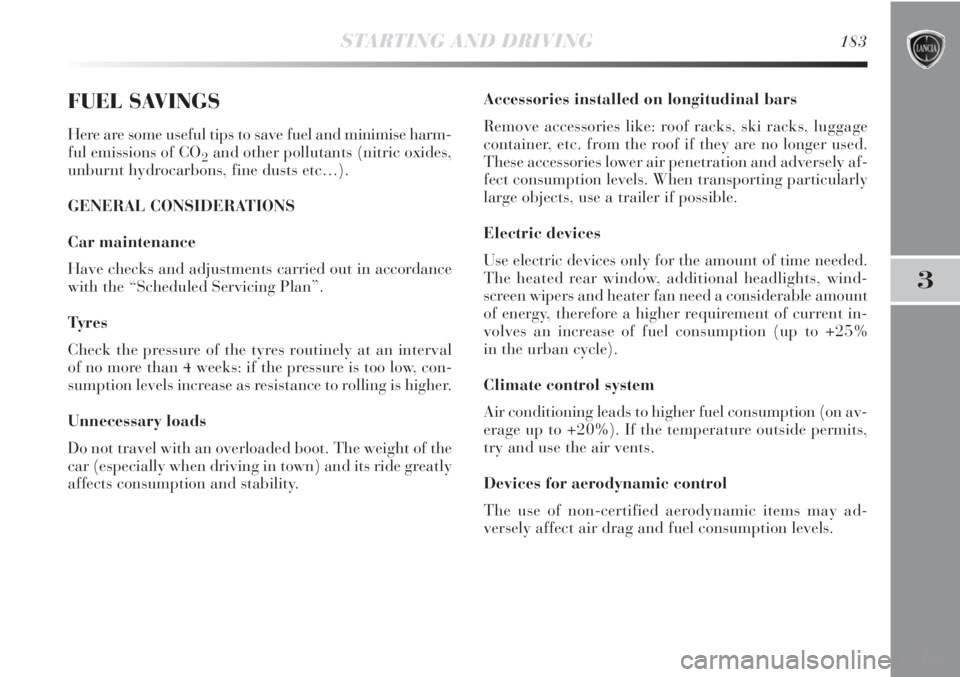
3
STARTING AND DRIVING183
FUEL SAVINGS
Here are some useful tips to save fuel and minimise harm-
ful emissions of CO
2and other pollutants (nitric oxides,
unburnt hydrocarbons, fine dusts etc…).
GENERAL CONSIDERATIONS
Car maintenance
Have checks and adjustments carried out in accordance
with the “Scheduled Servicing Plan”.
Ty r e s
Check the pressure of the tyres routinely at an interval
of no more than 4 weeks: if the pressure is too low, con-
sumption levels increase as resistance to rolling is higher.
Unnecessary loads
Do not travel with an overloaded boot. The weight of the
car (especially when driving in town) and its ride greatly
affects consumption and stability.Accessories installed on longitudinal bars
Remove accessories like: roof racks, ski racks, luggage
container, etc. from the roof if they are no longer used.
These accessories lower air penetration and adversely af-
fect consumption levels. When transporting particularly
large objects, use a trailer if possible.
Electric devices
Use electric devices only for the amount of time needed.
The heated rear window, additional headlights, wind-
screen wipers and heater fan need a considerable amount
of energy, therefore a higher requirement of current in-
volves an increase of fuel consumption (up to +25%
in the urban cycle).
Climate control system
Air conditioning leads to higher fuel consumption (on av-
erage up to +20%). If the temperature outside permits,
try and use the air vents.
Devices for aerodynamic control
The use of non-certified aerodynamic items may ad-
versely affect air drag and fuel consumption levels.
Page 209 of 295

IN AN EMERGENCY207
4
Halogen bulbs contain gas under pressure;
if they break, glass fragments may be dis-
persed.IMPORTANT The headlight inner surface might be
slightly misted: this should not be considered irregular
rather a natural phenomenon due to low temperature and
the air humidity level. Misting will disappear as soon as
the headlights are turned on. The presence of drops in-
side the headlights indicates infiltration of water. Contact
a Lancia Dealership.
IMPORTANT When the weather is cold or damp or after
heavy rain or after washing, the surface of headlights or
rear lights, may steam up and/or form drops of conden-
sation on the inside. This is a natural phenomenon due
to the difference in temperature and humidity between the
inside and the outside of the glass which does not indicate
a fault and does not compromise the normal operation of
lighting devices. The mist disappears quickly when the
lights are turned on, starting from the centre of the dif-
fuser, extending progressively towards the edges.
When handling halogen bulbs, only touch the
metal part. If the transparent bulb is touched
with the fingers, its lighting intensity is re-
duced and life of the bulb may be compromised. In
the event of accidental contact, wipe the bulb with
a cloth moistened with alcohol and leave it to dry.
Where possible, it is advisable to have bulbs
changed at a Lancia Dealership. Proper op-
eration and orientation of the external lights
are essential for driving safety and complying
with the law.
Page 212 of 295

210IN AN EMERGENCY
REPLACING EXTERIOR BULBS
FRONT LIGHT CLUSTERS fig. 15
These contain the bulbs for the dipped beams, main
beams and direction indicators. The bulbs are arranged
as follows:
A. Main beam headlights:
B. Dipped beam headlights;
C. Direction indicators DIPPED BEAM HEADLIGHTS
With incandescent bulbs
To change the bulb, proceed as follows:
❍remove the protective cover B-fig. 15;
❍release the bulb holder clip A-fig. 16;
❍disconnect the electrical connector B;
❍remove the bulb C and replace it;
❍fit the new bulb, ensuring that the outline of the metal
part coincides with the splining on the curve of the
headlight. Then reconnect the electrical connector B
and reattach the bulb holding clip A;
❍refit the protective cover B-fig. 15.
fig. 15L0E0154mfig. 16L0E0155m
Page 213 of 295

IN AN EMERGENCY211
4
With gas discharge bulbs (Xenon)
(for versions/markets where provided)
MAIN BEAM HEADLIGHTS
With incandescent bulbs
To change the bulb, proceed as follows:
❍remove the protective cover A-fig. 15;
❍release the bulb holder clip A-fig. 17;
❍disconnect the electrical connector B;
❍remove the bulb C and replace it;
❍fit the new bulb, ensuring that the outline of the metal
part coincides with the splining on the curve of the
headlight. Then reconnect the electrical connector B
and reattach the bulb holding clip A;
❍refit the protective cover A-fig. 15.
fig. 17L0E0156m
Due to the high power supply voltage, gas
discharge bulbs (Xenon) should only be re-
placed by specialised personnel: danger of
death! Go to a Lancia Dealership.
With gas discharge bulbs (Xenon)
(for versions/markets where provided)
Due to the high power supply voltage, gas
discharge bulbs (Xenon) should only be re-
placed by specialised personnel: danger of
death! Go to a Lancia Dealership.
Page 225 of 295

IN AN EMERGENCY223
4
FUSE SUMMARY TABLE
F12
F12
F13
F13
F31
F33
F34
F35
F36
F37
F38
F39
F40
F417.5
15
7.5
15
5
20
20
5
20
7.5
10
10
30
7.538
38
38
38
38
38
38
38
38
38
38
38
38
38
USERS FUSE AMPS FIGURE
Right dipped beam headlight
Right dipped beam headlight (Xenon gas discharge bulb)
Left dipped beam headlight, headlight alignment corrector
Left dipped beam headlight (Xenon gas discharge bulb)
Climate control system fan relay coil, body computer
Left rear window winder
Right rear window winder
Reversing lights, engine compartment junction unit relay coils,
brake light pedal control (normally closed contact),
water in diesel sensor, air flow meter/control on clutch pedal
and brake servo pressure sensor (1.4 Turbo Multi Air versions)
Central locking system control unit, fuel flap,
dead lock, tailgate release
Third brake light, instrument panel, Adaptive Headlights Node
(1.4 Turbo Multi Air versions excluded), control unit on left hand
gas discharge headlight (1.4 Turbo Multi Air versions excluded)
Front roof lights, rear central roof light, driver side and passenger side sun
visor lights, luggage compartment roof light, glove compartment courtesy
light (Platinum trim level with optional sun roof - excluding MultiAir version)
Radio wiring/Radio/Radio Navigator (excluding MultiAir versions),
Blue&Me
TMNode, alarm siren, alarm system on roof light, climate control
unit, tyre pressure monitoring system control unit, diagnosis socket connector,
rear roof lights, voltage stabiliser (MultiAir versions without optional HI-FI)
Heated rear window
Electric door mirror demisters, demisters on windscreen jets
Page 227 of 295
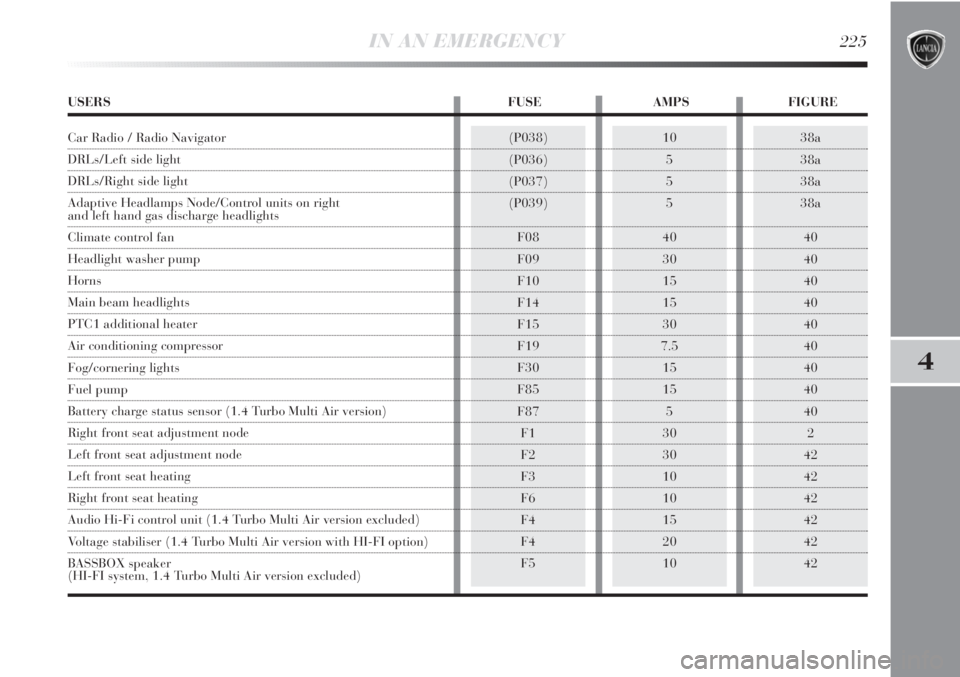
IN AN EMERGENCY225
4
38a
38a
38a
38a
40
40
40
40
40
40
40
40
40
2
42
42
42
42
42
42(P038)
(P036)
(P037)
(P039)
F08
F09
F10
F14
F15
F19
F30
F85
F87
F1
F2
F3
F6
F4
F4
F510
5
5
5
40
30
15
15
30
7.5
15
15
5
30
30
10
10
15
20
10
USERS FUSE AMPS FIGURE
Car Radio / Radio Navigator
DRLs/Left side light
DRLs/Right side light
Adaptive Headlamps Node/Control units on right
and left hand gas discharge headlights
Climate control fan
Headlight washer pump
Horns
Main beam headlights
PTC1 additional heater
Air conditioning compressor
Fog/cornering lights
Fuel pump
Battery charge status sensor (1.4 Turbo Multi Air version)
Right front seat adjustment node
Left front seat adjustment node
Left front seat heating
Right front seat heating
Audio Hi-Fi control unit (1.4 Turbo Multi Air version excluded)
Voltage stabiliser (1.4 Turbo Multi Air version with HI-FI option)
BASSBOX speaker
(HI-FI system, 1.4 Turbo Multi Air version excluded)
Page 233 of 295
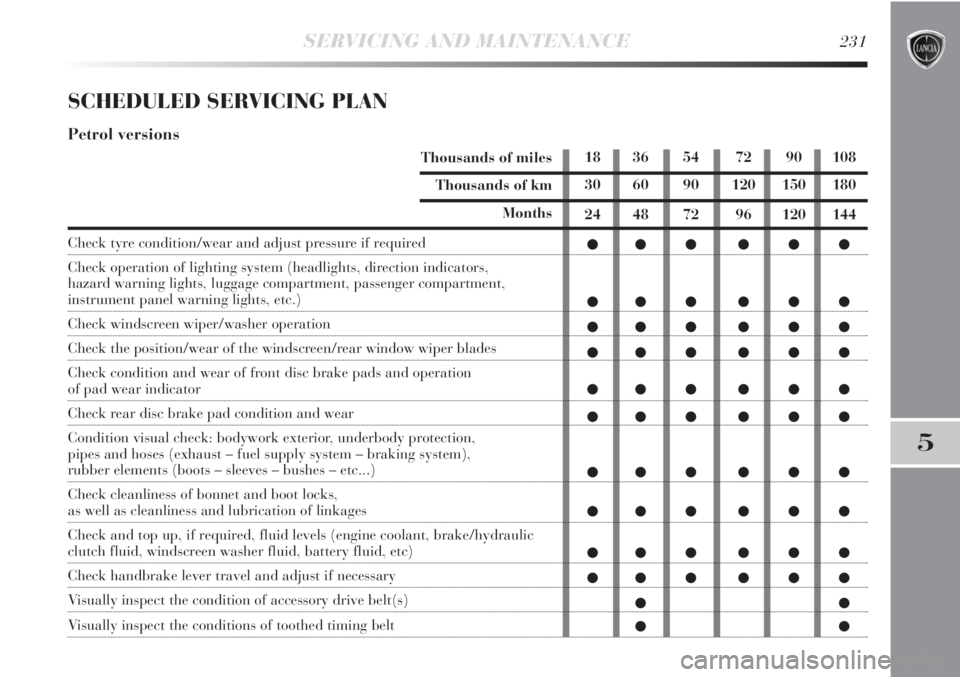
18 36 54 72 90 108
30 60 90 120 150 180
24 48 72 96 120 144
●●● ●●●
●●● ●●●
●●● ●●●
●●● ●●●
●●● ●●●
●●● ●●●
●●● ●●●
●●● ●●●
●●● ●●●
●●● ●●●
●●
●●
SERVICING AND MAINTENANCE231
5
SCHEDULED SERVICING PLAN
Petrol versions
Thousands of miles
Thousands of km
Months
Check tyre condition/wear and adjust pressure if required
Check operation of lighting system (headlights, direction indicators,
hazard warning lights, luggage compartment, passenger compartment,
instrument panel warning lights, etc.)
Check windscreen wiper/washer operation
Check the position/wear of the windscreen/rear window wiper blades
Check condition and wear of front disc brake pads and operation
of pad wear indicator
Check rear disc brake pad condition and wear
Condition visual check: bodywork exterior, underbody protection,
pipes and hoses (exhaust – fuel supply system – braking system),
rubber elements (boots – sleeves – bushes – etc...)
Check cleanliness of bonnet and boot locks,
as well as cleanliness and lubrication of linkages
Check and top up, if required, fluid levels (engine coolant, brake/hydraulic
clutch fluid, windscreen washer fluid, battery fluid, etc)
Check handbrake lever travel and adjust if necessary
Visually inspect the condition of accessory drive belt(s)
Visually inspect the conditions of toothed timing belt
Page 235 of 295
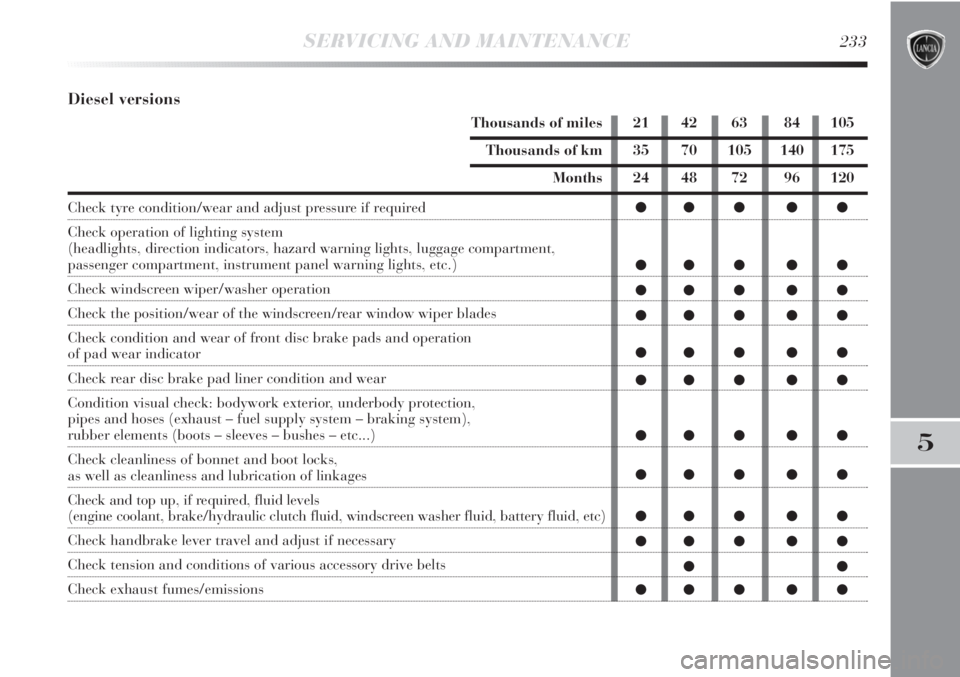
SERVICING AND MAINTENANCE233
5
21 42 63 84 105
35 70 105 140 175
24 48 72 96 120
●● ● ● ●
●● ● ● ●
●● ● ● ●
●● ● ● ●
●● ● ● ●
●● ● ● ●
●● ● ● ●
●● ● ● ●
●● ● ● ●
●● ● ● ●
●●
●● ● ● ●
Diesel versions
Thousands of miles
Thousands of km
Months
Check tyre condition/wear and adjust pressure if required
Check operation of lighting system
(headlights, direction indicators, hazard warning lights, luggage compartment,
passenger compartment, instrument panel warning lights, etc.)
Check windscreen wiper/washer operation
Check the position/wear of the windscreen/rear window wiper blades
Check condition and wear of front disc brake pads and operation
of pad wear indicator
Check rear disc brake pad liner condition and wear
Condition visual check: bodywork exterior, underbody protection,
pipes and hoses (exhaust – fuel supply system – braking system),
rubber elements (boots – sleeves – bushes – etc...)
Check cleanliness of bonnet and boot locks,
as well as cleanliness and lubrication of linkages
Check and top up, if required, fluid levels
(engine coolant, brake/hydraulic clutch fluid, windscreen washer fluid, battery fluid, etc)
Check handbrake lever travel and adjust if necessary
Check tension and conditions of various accessory drive belts
Check exhaust fumes/emissions
Page 237 of 295
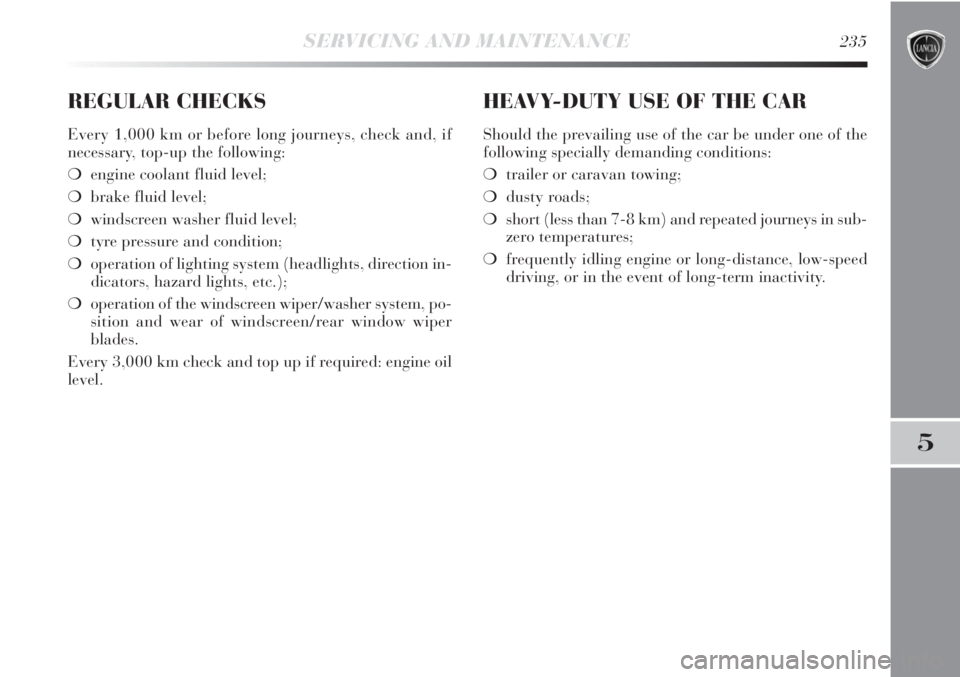
SERVICING AND MAINTENANCE235
5
REGULAR CHECKS
Every 1,000 km or before long journeys, check and, if
necessary, top-up the following:
❍engine coolant fluid level;
❍brake fluid level;
❍windscreen washer fluid level;
❍tyre pressure and condition;
❍operation of lighting system (headlights, direction in-
dicators, hazard lights, etc.);
❍operation of the windscreen wiper/washer system, po-
sition and wear of windscreen/rear window wiper
blades.
Every 3,000 km check and top up if required: engine oil
level.
HEAVY-DUTY USE OF THE CAR
Should the prevailing use of the car be under one of the
following specially demanding conditions:
❍trailer or caravan towing;
❍dusty roads;
❍short (less than 7-8 km) and repeated journeys in sub-
zero temperatures;
❍frequently idling engine or long-distance, low-speed
driving, or in the event of long-term inactivity.
Page 257 of 295
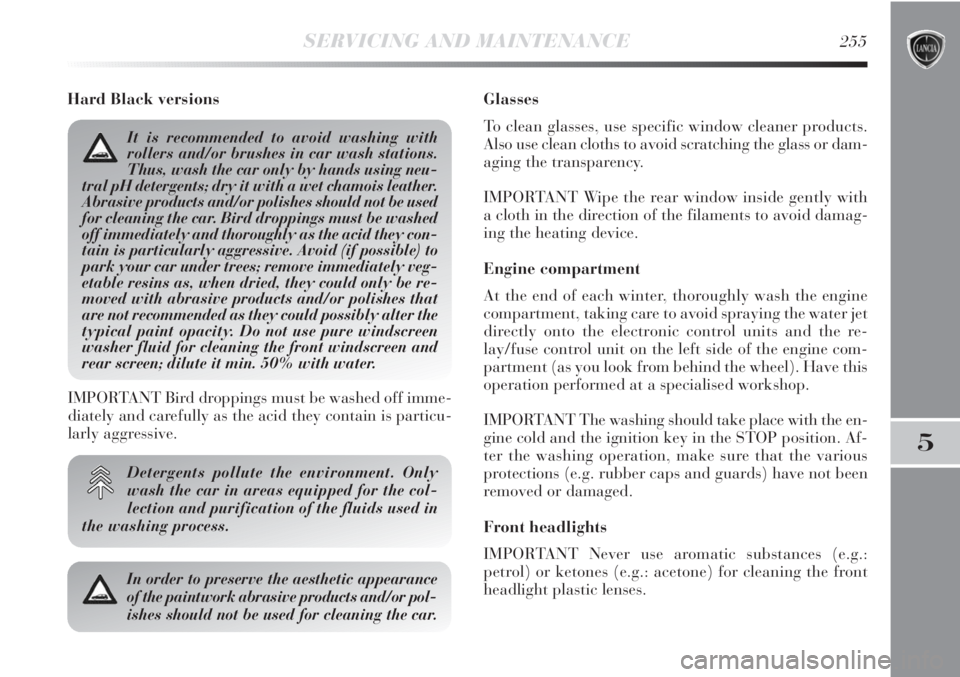
SERVICING AND MAINTENANCE255
5
Hard Black versions
Detergents pollute the environment. Only
wash the car in areas equipped for the col-
lection and purification of the fluids used in
the washing process.
Glasses
To clean glasses, use specific window cleaner products.
Also use clean cloths to avoid scratching the glass or dam-
aging the transparency.
IMPORTANT Wipe the rear window inside gently with
a cloth in the direction of the filaments to avoid damag-
ing the heating device.
Engine compartment
At the end of each winter, thoroughly wash the engine
compartment, taking care to avoid spraying the water jet
directly onto the electronic control units and the re-
lay/fuse control unit on the left side of the engine com-
partment (as you look from behind the wheel). Have this
operation performed at a specialised workshop.
IMPORTANT The washing should take place with the en-
gine cold and the ignition key in the STOP position. Af-
ter the washing operation, make sure that the various
protections (e.g. rubber caps and guards) have not been
removed or damaged.
Front headlights
IMPORTANT Never use aromatic substances (e.g.:
petrol) or ketones (e.g.: acetone) for cleaning the front
headlight plastic lenses.
In order to preserve the aesthetic appearance
of the paintwork abrasive products and/or pol-
ishes should not be used for cleaning the car.
IMPORTANT Bird droppings must be washed off imme-
diately and carefully as the acid they contain is particu-
larly aggressive.
It is recommended to avoid washing with
rollers and/or brushes in car wash stations.
Thus, wash the car only by hands using neu-
tral pH detergents; dry it with a wet chamois leather.
Abrasive products and/or polishes should not be used
for cleaning the car. Bird droppings must be washed
off immediately and thoroughly as the acid they con-
tain is particularly aggressive. Avoid (if possible) to
park your car under trees; remove immediately veg-
etable resins as, when dried, they could only be re-
moved with abrasive products and/or polishes that
are not recommended as they could possibly alter the
typical paint opacity. Do not use pure windscreen
washer fluid for cleaning the front windscreen and
rear screen; dilute it min. 50% with water.